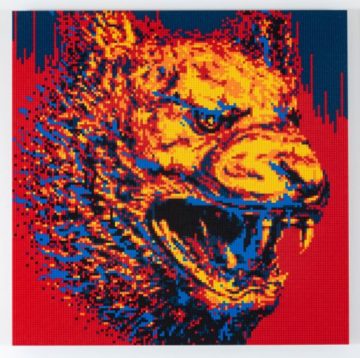
Originally published in the Marina Times San Francisco in July 2022
AI Weiwei Returns to San Francisco with Everyday Monuments at the Haines Gallery
Ai Weiwei is bringing his sociopolitical inspired art to the Haines Fort Mason Gallery through August 27th. This will be his first exhibit in San Francisco since 2016. Everyday Monuments shines a light on people, places and events that may otherwise be forgotten. The exhibit consists of 18 works in materials such as LEGO, marble, and wood, each a synthesis of complex historical, cultural and political references.
Ai Weiwei was born in China in 1957. As an outspoken champion of human rights, his cultural criticism and activism has made him a natural target for Chinese authorities who attempt to censor the artist and his output. Not to be discouraged, Ai continues to turn activism and adversity into art.
Zodiac
This exhibition marks the San Francisco debut of Ai’s Zodiac (2018). Twelve panels made of thousands of brightly hued LEGO bricks depict the mythical animals of the traditional Chinese Zodiac, a system ascribing personality traits to years of birth. Appearing in the gallery in astrological order, the body of work is inspired by the Zodiac Fountain in Yuanmingyuan, Beijing’s Old Summer Palace. This epic water clock consisting of twelve monumental bronze animal heads was looted by Anglo-French troops who took part in the destruction of Yuanmingyuan in 1860 during the Second Opium War. Reclamation of cultural relics from the colonial past is an ongoing global talking point in the art world, and occasionally these bronze heads resurface in the marketplace. Though they have appeared for sale – most famously at Christie’s 2009 auction of the Yves Saint Laurent and Pierre Berge Collection – only seven of the Zodiac heads have been recovered to date. Presenting the Chinese Zodiac using a children’s toy, Ai’s Zodiac heads in LEGO recreate monuments out of everyday materials and because of their shape, the artworks are reminiscent of the geometry of computerized images consisting of pixels.
Rebar
Rebar (2014) casts everyday objects in marble, creating a memorial. Rebar emerged from the aftermath of a massive earthquake that struck Sichuan Province on May 12, 2008, killing nearly 90,000 people, among them thousands of school children. The children’s deaths were caused, in part, by faulty school construction. Bereaved parents, outraged by the needless deaths of their children, were met with swift retribution and were silenced by Chinese authorities. Ai worked with other activists to investigate the cover up since the Chinese government tried to erase the event. His work yielded the names and details of 5,197 schoolchildren who had perished in the earthquake and whose identities had disappeared from the public record. Each twisted rod of carved marble is placed on top of wooden frames shaped like tiny coffins as monuments to lives lost.
Shedding Light on political corruption with Lantern and Ceiling Lamp with Stars
After a massive public outcry for his freedom, Ai Weiwei was released in the summer of 2011 after being imprisoned for 81 days. Ai was brutally beaten by police and disappeared into custody for his human rights activism, though the official reason was “economic crimes.” Though he was freed, his passport was taken away and he was surveilled by video cameras that once surrounded his Beijing studio. The Lantern (2014) is Ai’s mocking response to the video cameras which he decorated with red paper lanterns associated with festivals. Beautifully carved in marble, they exist as an ornamental testament to what the artist endured. Ceiling Lamp with Stars (2014) is a reproduction of a light fixture commonly found in Communist China during the 1950’s and 60’s. The marble sculpture is covered in five pointed stars, a symbol of the Communist party and speaks to the bygone age of Soviet-inspired design. Ai’s activities post-imprisonment continue to spark meaningful dialogue as his observations about justice continue to reach wider audiences. After his passport was returned in 2015, Ai has lived in Berlin, Cambridge, and now resides in Portugal.
Ai Weiwei presents art as an opportunity to deconstruct the values of society and encourages his viewers to do one small thing every day to prove the existence of justice. The role of the individual is a role of power. Ai explains: “I call on people to be ‘obsessed citizens’, forever questioning and asking for accountability. That’s the only chance we have today of a healthy and happy life.”